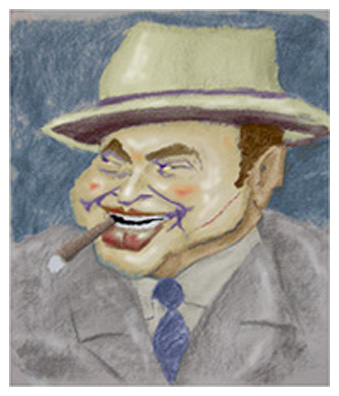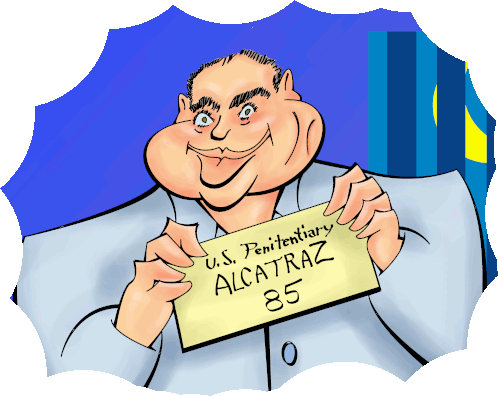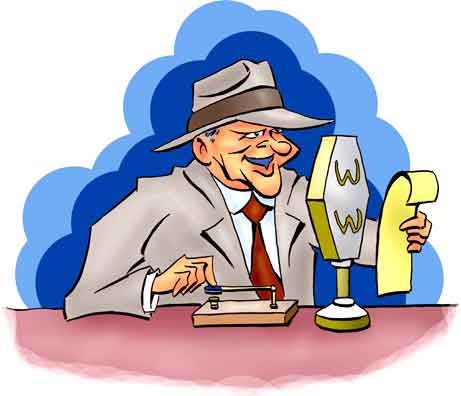Certainly it seems that Ian - or rather his fictional creation James Bond - was overly opinionated. So much that recently the original James Bond novels have undergone - well, we'll call it "editing" to be more palatable to 21st Century standards of propriety.
But it is true that Frank Nitto - which was his real name and what he always called himself - was actually quite short. Although his biography states he was 5 feet 6 inches tall, it qualifies this datum with the phrase "at best". Indeed, photographs of Frank show he is inevitably the shortest man in the room and noticeably so. Although anthropometrical estimations must needs be approximate when using photographs of men in pressy 1930's suits and wearing long overcoats and whose statures are unknown, Frank may have hit 5'4" in his shoes.
Al "Scarface" Capone

Before

After
Francesco Raffaele Nitto was born in Italy in 1886. His family immigrated to New York around 1890 where young Frank (as he began calling himself) became a barber. Since at that time barber shops were still centers of masculine camaraderie, Frank found he could serve as a broker for items which others had obtained for resale. The less courteous would call Frank a "fence" for stolen goods.
By the end of World War I, Frank was living in Chicago. With Prohibition in full swing, he became part of the "Chicago Outfit" that had been organized by Vincenzo "Big Jim" Colosimo (pronounced koh-LOSS-ee-moh) and his lieutenant Johnny "The Fox" Torrio with a little help from Johnny's right hand man, Alphonse "Scarface" Capone. Then after Big Jim met his end in the doorway of his restaurant, Johnny left for Italy after being ambushed when getting home from a shopping trip, and Al got hauled off to the slammer, by the mid-1930's Frank was one of the last men standing.
An interesting fun fact about the Chicago mob is that Frank's position may not have been quite as definitive as sometimes thought. Although historically he is mentioned as the man who assumed the helm after Al went to prison, it's possible that Frank, far from being in charge of the mob, was more of a front man. That is, he was perfect for appearing in the newspaper stories as the "Boss" but he was also there to take the fall if things went wrong. Which ultimately is what happened.
With the repeal of Prohibition in 1933, a major source of income for organized crime had dried up. True, other business opportunities remained - the numbers racket, casino gambling, loan-sharking, extorting "protection" money, drugs, and providing services for gentleman-specific recreation. But these activities didn't attract the sheer numbers of ordinary citizens that the illegal "speaks" had. So it fell to Frank to branch out.
One of Frank's wise ideas was to get into labor racketeering in general and with the motion picture industry in particular. And he got into this business in a most interesting manner.
Once Prohibition was over a small time hoodlum named Willie "The Squealer" Bioff - described rather discourteously by newspaper reporters as "pudgy" - had become the official representative of the Chicago Theatrical Workers Union. Together with the president of the union, George Browne, Willie told the local theater owners, managers, and impresarios that he and George would work out a no-strike agreement. Of course, he and George would require a - quote - "professional fee" - unquote for their services. But Willie assured them, the money would go to good use as it would be (chuckle) to help theatrical workers who are out of employment.
How much would this fee be? Well, Willie mused, $25,000 a month would be fine, thank you.
The theatrical bigwigs, rather than go to the police and report what was clearly an extortion racket, did some figuring. With a no-strike agreement in place, they could keep salaries down. So even shucking out an annual "contribution" of $300,000 to Willie and George, the theaters would rake in more money than ever before.
There was another consideration. The - quote - "fee" - unquote - for Willie and George was nominally a charitable contribution. That meant that the money was tax deductible - good for the pocket book and good for public relations. So maybe a little of this racketeering and extortion wasn't so bad after all.
It didn't take long for news of this independent operation to come to the attention of Frank. He invited Willie and George to a conference. There he said they could keep running their - ah - "charity" - provided they kicked 50% back to The Outfit. Knowing there was only one viable answer, Willie and George agreed and so became part of the Chicago Mob.
But Frank also pointed out that Willie and George's aims were too modest. There would be even more money if they went national. To this end Willie was given the job of extending the operation to the rest of the country. So Willie followed Horace Greeley's advice and headed West.
Soon the major Hollywood motion picture studios were siphoning off part of their cash to Willie. Frank was so pleased that he told Willie that the Chicago Outfit's cut would now be 90%. But since 10% of the new takings was more than Willie and George ever made on their own, they were happy to oblige and Willie relocated permanently to Hollywood.
One rule for crooks is don't make yourself conspicuous and don't flash your wealth. That attracts too much attention from the wrong people. But Willie began spending his ill-gotten gains like water, and soon the honest union leaders began to notice this newcomer with the fancy duds, expensive automobiles, and the Hollywood mansion. So the head of the Screen Actor's Guild suggested to the government that perhaps they should take a peek at Willie's finances.
The investigation quickly bore fruit, and in 1941 Willie and George were indicted for income tax evasion. Among the witnesses was Albert Warner - one of the Warner Brothers - who testified that he personally handed over $100,000 to Willie. Despite a cross examination where Willie's lawyer tried to show Albert and Willie were really friends, Willie got sentenced to a whopping 10 years. Of course, if he were a good boy he might get some time shaved off. And being a good boy meant he needed to cooperate with the authorities.
Back in Chicago, Frank and his friends began to sweat that Willie "The Squealer" was becoming, well, Willie the Squealer. So on March 18, 1943, everyone met in Frank's nice but hardly ostentatious suburban home. There the others expressed their displeasure at Frank's management. It was his bright idea to get involved with the Hollywood unions. And now look where they were!
But the boys assured Frank that he could set things aright. He could tell the Feds that the whole idea had been his. Then Frank would take the rap and go to prison. And if that didn't work, then he could keep Willie from squealing. That was simple enough. He could "deal" with Willie, and if necessary, right in the courtroom.
The next day the government issued the remaining indictments. Specifically Frank and his friends were charged with extorting over $2,500,000 from the Hollywood studios. Among those charged were Frank, Louis "Little New York" Campagna, Phil D'Andrea, Francis "Frank Diamond" Maritote (whose brother married Al Capone's sister), Ralph Pierce, Charles "Cherry Nose" Gioe, John "Handsome Johnny" Rosselli, Louis Kaufman, and last but far from least Paul "The Waiter" Ricca. Now these fellas were really ticked at Frank who had few options to his advantage.
By now you've probably figured out that if Frank was indicted in 1943 then he wasn't thrown off a roof by Eliot Ness a decade earlier as depicted in the 1987 movie The Untouchables. Typical of many of Hollywood "true adventures", the scene was entirely fabricated, horse hockey, bullshine, and poppycock.
Instead on the day of the indictments, March 19, 1943, two railroad workers of the North Riverside Central Illinois Railway Yard noticed a man walking along the track. He was carrying what looked like a bottle of whiskey and he seemed to be walking around drunkenly and even lurched in front of an oncoming train before moving aside. Then as he neared the barrier fence, he suddenly dropped from sight. After some hesitation the men walked over and found the man laying against the fence, pistol in hand and quite dead. When the police arrived they immediately recognized Frank Nitti.
Like so many public figures whose heyday was before the Second World War, Frank Nitti remained unknown to the post-war generation until he became part of a television show. Of course, the scriptwriters couldn't pick someone who looked like Frank Nitti to play Frank Nitti.
So they picked Bruce Gordon. Bruce was a well-known character actor with a long list of acting credits ranging over The Buccaneer, 77 Sunset Strip, Bat Masterson, Westinghouse Desilu Playhouse, Behind Closed Doors, Naked City, Peter Gunn, Jefferson Drum, Tomsbstone Territory, Decoy, Trackdown, The Walter Winchell Fil, Maverick, Perry Mason, M Squad, Sugarfoot, Have Gun - Will Travel, The Lark, Gunsmoke, Omnibus, Hallmark Hall of Fame, Lux Video Theatre, Robert Montgomery Presents, Love Happy, Studio One, The Philco Television Playhouse, The Street with No Name, and The Naked City. His roles varied from cowboys to (no kidding) Pontius Pilate. He could also play Shakespeare and he appeared on Broadway in productions of King Richard II and Antony and Cleopatra. But chief among Bruce's virtues for his casting in The Untouchables was he not only stood tall at six feet but his rugged and pugnacious visage just looked like a gangster.
The idea of a show about the Untouchables originated from a childhood friend of Al Capone's son, Albert. Young Albert - called Sonny by friends and family - had gone to school with Desi Arnaz who in the 1950's had finished co-starring in I Love Lucy with his wife Lucille Ball.
So when I Love Lucy ended, they were looking for productions for their film company, Desilu. They had purchased the rights of the book The Untouchables which was written by Eliot Ness and sportswriter Oscar Fraley but not published until after Eliot's death in 1957.

Narrated by Walter Winchell
Casting Robert Stack cast as Eliot, Neville Brand as Al Capone, Bruce as Frank Nitti, and with Walter Winchell providing narration in his staccato machine-gun-like delivery, the two-part made-for-TV movie "The Untouchables" was broadcast in 1959 on Desilu Playhouse. The audience response was positive enough so that the ABC network agreed to produce the show as a series. The original TV movie was renamed as "The Scarface Mob" and used as the pilot.
The big historical glitch in the series, of course, is that except for the pilot and a later two-part episode, Al Capone isn't in the show. Instead, Al is in prison and Eliot Ness and his Untouchables continue fighting crime and battling other crooks like Arthur Flegenheimer (better known as Dutch Schultz), Harry Strauss (Pittsburgh Phil), Ma Baker and her boys, and of course Frank Nitti. In reality once Al was sent to prison in 1931, the Untouchables were disbanded and they went their separate professional ways.
Exactly why Al was left out of most of the episodes has never been entirely figured out but we do know that Al's widow, Mae, claimed the show was profiting from her husband's name and tried to stop the production. She didn't succeed, of course, but dropping Al from the show and putting Frank in charge made the question of Al's participation a moot point.
After The Untouchables Bruce continued to act on television and in films. Among his appearances were on Timerider, Simon and Simon, The Hardy Boys / Nancy Drew, Joe Forrester, Lucy Gets Lucky, The Manhunter, The Partners , Machismo, Hello Down There, Blondie, The Doris Day Show, Here's Lucy, Adam-12, Tarzan and the Four O'Clock Army, Mannix, He and She, Ironside, The Girl from U.N.C.L.E., Run Buddy Run, Tarzan, Get Smart (where he played a detective), Bob Hope Presents the Chrysler Theatre, The Tower of London, The Lucy Show, Rider on a Dead Horse, Cain's Hundred, Route 66, Surfside 6, Key Witness, Outlaws, The Barbara Stanwyck Show, The Chevy Mystery Show, The Detectives, Adventures in Paradise, Johnny Ringo, Riverboat, Bonanza, Tightrope, Curse of the Undead, One Step Beyond, and Piranha.
In the end, we see that if there's an example that crime never pays well enough, it's the life of Frank Nitti. Even though he took over from Al Capone as head of the Chicago Outfit, Frank ended up as a heap in a railyard at age 57. Bruce, though, kept going until 2011, a decade past the Millennium, age 94.
References and Further Reading
After Capone: The Life And World Of Chicago Mob Boss Frank "The Enforcer" Nitti, Mars Eghigian, Jr., Cumberland House Publishing, 2006.
Frank Nitti: The True Story of Chicago's Notorious "Enforcer", Ronald Humble, Barricade Books, 2007.
"Estimation of Human Height from the Length of Tibia", Dr. Manotosh Banerjee, Dr. Chiranjit Samanta, Semantics Scholar, 2015.
"Jury Indicts 8 Capone Henchmen in Movie Fraud", Rick Kogan, Imperial Valley [California] Press, March 19, 1943, p. 1.
"How Frank Nitti Met His Fate", Ronald Koziol and Edward Baumann, Chicago Tribune, June 20, 1987.
"Frank 'The Enforcer' Nitti: 1930s Crime boss Extorted Millions in Hollywood", Ron Grossman, Chicago Tribune, August 19, 2017.
"In Tales of the Chicago Outfit the Widowed Annette Nitti Mostly Stayed in the Shadows", Rick Kogan, Chicago Tribune, August 31, 2020.
"Tony Accardo Is Joe Batters: Our Fascination with Chicago Mob Bosses Continues with a New Tell-All Book", Rick Kogan, Chicago Tribune, Febrary 13, 2019.
"Warners Tells of Paying Bioff $100,000", Rick Kogan, Detroit Evening Times, October 21, 1941.
Straight Shooting, Robert Stack (with Mark Evans), MacMillan, 1980.
"Out On His Town with Al Capone", [Washington, D. C.] Evening Star, April 20, 1959, p. B-15.
"Desilu Playhouse", The Sunday Star Televue, p. 5. [Washington, D. C.] Sunday Star, April 19, 1959
"Bruce Gordon", Internet Broadway Database.